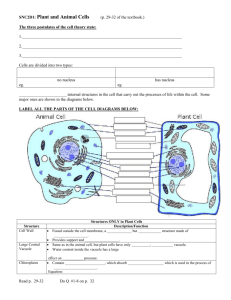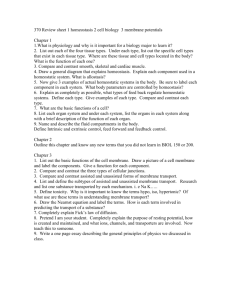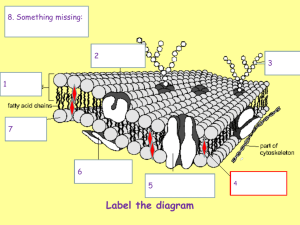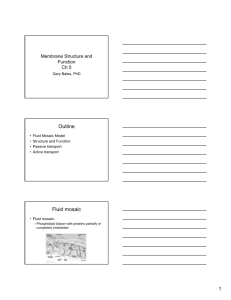Mediated transport, Osmosis
advertisement
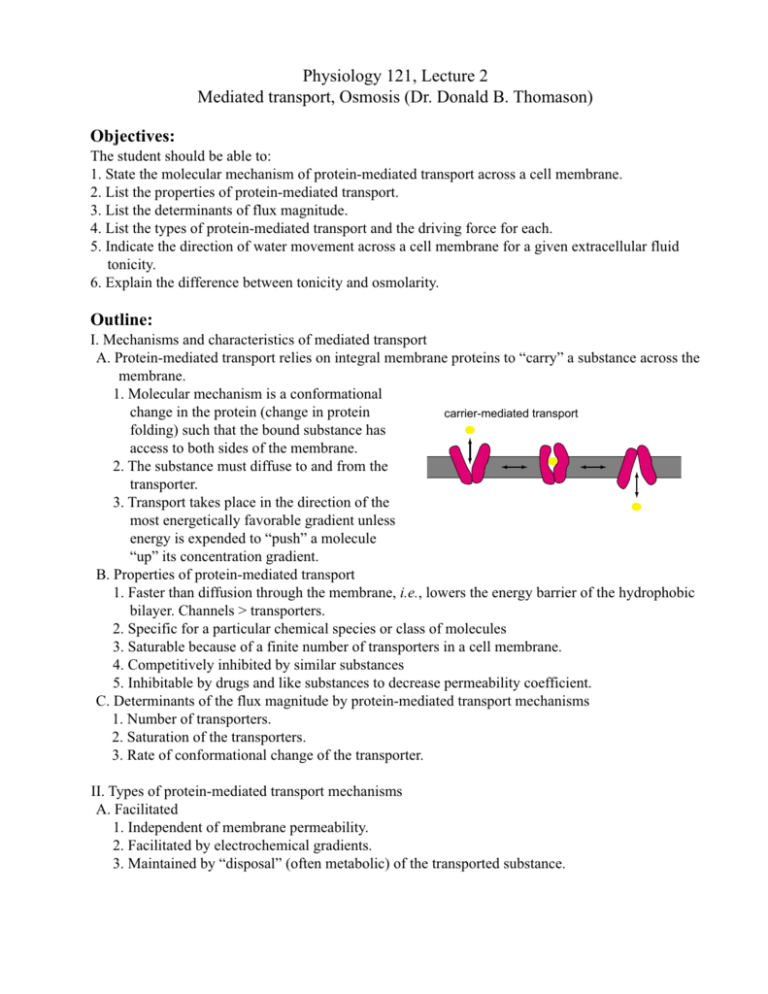
Physiology 121, Lecture 2 Mediated transport, Osmosis (Dr. Donald B. Thomason) Objectives: The student should be able to: 1. State the molecular mechanism of protein-mediated transport across a cell membrane. 2. List the properties of protein-mediated transport. 3. List the determinants of flux magnitude. 4. List the types of protein-mediated transport and the driving force for each. 5. Indicate the direction of water movement across a cell membrane for a given extracellular fluid tonicity. 6. Explain the difference between tonicity and osmolarity. Outline: I. Mechanisms and characteristics of mediated transport A. Protein-mediated transport relies on integral membrane proteins to “carry” a substance across the membrane. 1. Molecular mechanism is a conformational change in the protein (change in protein carrier-mediated transport folding) such that the bound substance has access to both sides of the membrane. 2. The substance must diffuse to and from the transporter. 3. Transport takes place in the direction of the most energetically favorable gradient unless energy is expended to “push” a molecule “up” its concentration gradient. B. Properties of protein-mediated transport 1. Faster than diffusion through the membrane, i.e., lowers the energy barrier of the hydrophobic bilayer. Channels > transporters. 2. Specific for a particular chemical species or class of molecules 3. Saturable because of a finite number of transporters in a cell membrane. 4. Competitively inhibited by similar substances 5. Inhibitable by drugs and like substances to decrease permeability coefficient. C. Determinants of the flux magnitude by protein-mediated transport mechanisms 1. Number of transporters. 2. Saturation of the transporters. 3. Rate of conformational change of the transporter. II. Types of protein-mediated transport mechanisms A. Facilitated 1. Independent of membrane permeability. 2. Facilitated by electrochemical gradients. 3. Maintained by “disposal” (often metabolic) of the transported substance. B. Active, primary. 1. Depends directly on the expenditure of energy by the transporter. 2. Can transport substances “up” their concentration gradient. Primary Active Transport outside 2K + Na/K ATPase ATP ADP 2K inside C. Active, secondary 1. Depends indirectly on the expenditure of energy for the primary active transport of an ion 2. Couples the transport of the ion moving “down” its electrochemical gradient to provide the energy required to move another substance “up” its electrochemical gradient. 3. Types of coupled transport: a. symport b. antiport + 3 Na + + 3 Na Secondary Active Transport outside 2K + + 3 Na + Na Na/K ATPase + - 2 Cl NKCC ATP ADP 2K K + + 3 Na + Na K + - 2 Cl inside III. Osmosis Osmosis A. The concentration of water and solutes in Compartment 1 Compartment 2 solution. 1. Osmolarity. a. function of the number of particles dissolved in solution. b. the particles take up space, decreasing the concentration of water. c. water will move down its concentration gradient. d. specific channels/transporters for water exist in cell membranes 2. Penetrating and non-penetrating solutes. a. penetrating solutes are permeable to the cell membrane. i. if they equilibrate across the membrane, they will affect water concentration to the same extent on both sides of the membrane. ii. example is urea. b. non-penetrating solutes cannot cross the cell membrane. i. they will affect water concentration only on the side of the membrane where they are “trapped.” ii. example is albumin B. Tonicity versus Osmolarity Osmolarity and Tonicity 1. Tonicity is the concentration of impermeant, Compartment 1 Compartment 2 osmotically active substances in solution. Osmolarity = Tonicity = a. an isotonic solution is roughly 300 mOsm/l impermeant impermeant dissolved substances. b. e.g., a living cell has approximately 300 + mOsm/l total K+, protein, and Cl- inside, so permeant a bathing solution of 150 mM/l NaCl (300 mOsm/l) is isotonic (all of these substances are relatively impermeant to a living cell). 2. Osmolarity is the concentration of both permeant and impermeant substance in solution. a. permeant substances will cross the membrane fairly quickly compared to water. b. therefore, the substance will equilibrate before much water movement (down its gradient) has taken place. 3. A solution need not have its tonicity = osmolarity, e.g. a. a 7% sucrose solution is isotonic and isoosmotic; b. a 10% ethanol solution is hyperosmotic; c. a 7% sucrose, 10% ethanol solution is isotonic and hyperosmotic. C. The movement of water across a semipermeable membrane. 1. Diffusion and transport. 2. Tonicity and cell volume.




